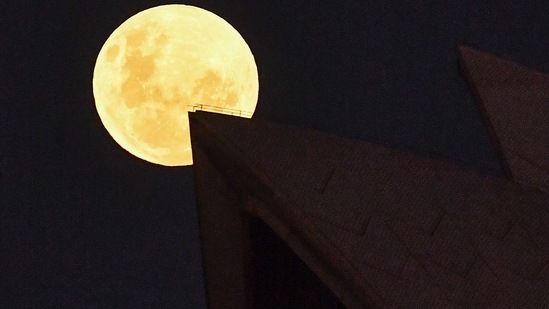Record Floods in 2030s Due to Moon 'Wobble' :NASA Predicted
The 'wobble' in the Moon's orbit lasts for 18.6 years, during which there is a tidal amplification phase, increasing the devastating effect of high tides. This cycle is expected to occur in the mid-2030s and, along with rising sea levels, could lead to more nuisance flooding, NASA said.
Climate change has caused sudden climatic changes on Earth, which has caused flooding in many countries, especially in the United States. But now, a new study has linked extreme weather events to Earth's neighbor, the moon.
The study has been carried out by the US space agency National Aeronautics and Space Administration (Nasa), which says that a 'wobble' in the Moon's orbit combined with rising sea levels due to climate change will cause devastating floods on Earth. .
The study was published in the journal Nature Climate Change on June 21.
Called 'nuisance floods', these currently occur in coastal areas when the tide reaches about 2 feet above the average daily high tide. These events are much more problematic for companies because they flood the streets and homes, affecting daily life.
These nuisance floods will become more frequent and irregular in the mid-2030s, according to a NASA study. Most of the coast of the United States will see a three- to four-fold increase at high tides for at least a decade, according to the study.
It has also warned that these floods won't be spread out evenly through the year, and expected to cluster together over the span of just a few months.
"Low-lying areas near sea level are increasingly at risk and suffering due to the increased flooding, and it will only get worse," said Nasa administrator Bill Nelson. "The combination of the Moon’s gravitational pull, rising sea levels, and climate change will continue to exacerbate coastal flooding on our coastlines and across the world."
Explaining the impact of the Moon on the flooding on Earth, the study's lead author Phil Thompson, an assistant professor at the University of Hawaii, said that the wobble in the Moon's orbit takes 18.6 years to complete. While the wobble has always been there, what makes it dangerous is that it will combine with the rising sea levels due to the planet's warming, said Thompson.
चंद्रमा की कक्षा में 'डगमगाने' 18.6 साल तक रहता है, जिसके दौरान ज्वारीय प्रवर्धन चरण होता है, जो उच्च ज्वार के विनाशकारी प्रभाव को बढ़ाता है। नासा ने कहा कि यह चक्र 2030 के दशक के मध्य में होने की उम्मीद है और समुद्र के बढ़ते स्तर के साथ-साथ और अधिक उपद्रव बाढ़ आ सकती है।
जलवायु परिवर्तन ने पृथ्वी पर अचानक जलवायु परिवर्तन का कारण बना दिया है, जिससे कई देशों में बाढ़ आ गई है, खासकर संयुक्त राज्य अमेरिका में। लेकिन अब, एक नए अध्ययन ने चरम मौसम की घटनाओं को पृथ्वी के पड़ोसी चंद्रमा से जोड़ा है।
अध्ययन अमेरिकी अंतरिक्ष एजेंसी नेशनल एरोनॉटिक्स एंड स्पेस एडमिनिस्ट्रेशन (नासा) द्वारा किया गया है, जो कहता है कि जलवायु परिवर्तन के कारण बढ़ते समुद्र के स्तर के साथ मिलकर चंद्रमा की कक्षा में 'डगमगाने' से पृथ्वी पर विनाशकारी बाढ़ आएगी। .
अध्ययन 21 जून को नेचर क्लाइमेट चेंज जर्नल में प्रकाशित हुआ था।
'उपद्रव बाढ़' कहा जाता है, ये वर्तमान में तटीय क्षेत्रों में होते हैं जब ज्वार औसत दैनिक उच्च ज्वार से लगभग 2 फीट ऊपर पहुंच जाता है। ये घटनाएँ कंपनियों के लिए बहुत अधिक समस्याग्रस्त हैं क्योंकि वे सड़कों और घरों में पानी भर देती हैं, जिससे दैनिक जीवन प्रभावित होता है।
नासा के एक अध्ययन के अनुसार, 2030 के दशक के मध्य में ये उपद्रव बाढ़ अधिक लगातार और अनियमित हो जाएगी। अध्ययन के अनुसार, संयुक्त राज्य के अधिकांश तट पर कम से कम एक दशक के लिए उच्च ज्वार में तीन से चार गुना वृद्धि देखी जाएगी।
इसने यह भी चेतावनी दी है कि ये बाढ़ पूरे वर्ष समान रूप से नहीं फैलेगी, और कुछ ही महीनों में एक साथ एकत्रित होने की उम्मीद है।
नासा के प्रशासक बिल नेल्सन ने कहा, "बढ़ती बाढ़ के कारण समुद्र के स्तर के पास के निचले इलाकों में जोखिम और पीड़ा बढ़ रही है, और यह केवल बदतर होगा।" "चंद्रमा के गुरुत्वाकर्षण खिंचाव, समुद्र के बढ़ते स्तर और जलवायु परिवर्तन का संयोजन हमारे समुद्र तटों और दुनिया भर में तटीय बाढ़ को बढ़ाता रहेगा।"
पृथ्वी पर बाढ़ पर चंद्रमा के प्रभाव के बारे में बताते हुए, अध्ययन के प्रमुख लेखक फिल थॉम्पसन, हवाई विश्वविद्यालय में एक सहायक प्रोफेसर ने कहा कि चंद्रमा की कक्षा में चक्कर को पूरा होने में 18.6 साल लगते हैं। थॉम्पसन ने कहा, जबकि डगमगाने हमेशा से रहा है, जो इसे खतरनाक बनाता है वह यह है कि यह ग्रह के गर्म होने के कारण बढ़ते समुद्र के स्तर के साथ जुड़ जाएगा।

Comments
Post a Comment